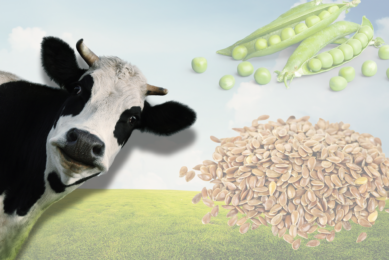DSM World Mycotoxin Survey 2023

Mycotoxins continued to provide the cereals sector with considerable challenges last year as producers turned to cheaper products to manage risks.
The Covid-19 pandemic affected logistics and availability of feed materials. This coupled with increased input and energy costs caused by the war in Ukraine meant significantly higher costs for producers. As a result, some farmers turned to cheaper products to manage their mycotoxin risk.
Annelise Mueller, global product manager DSM and responsible for its annual survey, which has been running since 2004, said a total of 27,279 samples were taken last year with 122,240 analyses from 87 countries for 6 main mycotoxins (aflatoxins, zearalenones (ZEN), fumonisins (FUM), deoxynivalenols (DON), ochratoxins and T-2s).
Areas with extreme risk category
Mueller said mycotoxin prevalence and risk last year was categorised as extreme in China, South Asia and North America with samples showing a total risk of more than 75%. The risk level expresses the percentage of samples testing positive for at least 1 mycotoxin above the threshold level in parts per billion (ppb).
For example, the total risk level in the China/Taiwan was 97% with FUM 93%, DON 84% and ZEN 82% being the most common mycotoxins found.
Samples from the Middle East and North Africa, Sub-Saharan and South Africa had total risk levels above the 50% threshold while levels were lower but still significant in Europe and Oceania.
European risk levels
DSM Animal Nutrition and Health mycotoxin risk managers, Dr Wolfgang Markert and Sander Janssen, spoke of varying results across Europe from the nearly 9,000 samples taken. The European risk level of around 40% contained some extremely high DON levels of, for example, 445,000ppb.
In all samples, DON was the most prevalent (46%), followed by ZEN (42%) and FUM (34%) although T-2 levels were significant at 34%. In corn, average levels of DON and ZEN were higher when compared to 2021 statistics.
…most concerning European statistics had come from Hungarian corn
Higher risk in southern & eastern Europe
In general, higher percentage of mycotoxins were found in southern and eastern Europe. For example, in Italian finished feed, FUM levels were very high (99%), with the hot climate ensuring that FUM grew easily. ZEN and DOM were also highly prevalent, and a 42% aflatoxin level was found. Aflatoxins can be transmitted from milk to humans.
Ukraine and Turkey
FUM was also found in 80% of Turkish samples, with high levels of contamination, while in Ukraine a high volumes of ZEN contamination were found in wheat grains samples with levels of 48ppb – close to the risk for sensitive species, such as piglets and up to a maximum of 153ppb. Janssen and Markert said if farmers were to mix grains from Ukraine with finished feed, mycotoxin levels could be too high, so proper analysis and mitigation methods were needed.
Hungary
Markert pointed out that some of the most concerning European statistics had come from Hungarian corn (kernels), where levels across all 6 mycotoxins were relatively high (76% DON, 72% FUM, 40% T-2, 37% ZEN, 33% OTA and 30% aflatoxin).
The Netherlands
Turning to the Dutch results, the presenters said the Netherlands imported a lot of compound feed and the results showed 67% contamination with more than 1 mycotoxin and some high T-2 ppb figures which can be a specific risk to poultry.
Middle East and Africa
Further afield, Janssen said samples in the Middle East and North Africa showed FUM mycotoxins were highly abundant and the prevalence of ZEN, FUM and especially DON and T-2 had increased, which was concerning for poultry producers. 100% of corn kernel samples were contaminated with at least 2 mycotoxins.
In sub-Saharan Africa, DON (67%) is the main risk, while ZEN and aflatoxin abundance increased, while there were nearly 800 samples taken from South Africa, showing that nearly 70% had more than 1 mycotoxin.
Advantages of rapid testing
Nora Kogelnik, Romer Labs product manager, talked about the main advantages of mycotoxin rapid tests, highlighting:
- Fast and precise results
- No laboratory experience needed
- Test and results can be carried out on-site
- Minimising/preventing disposal of organic solvents
However, while rapid testing is great for raw grains, nuts and grain by-products, Kogelnik admitted it was more limited for finished feed or silage samples. Finished feed is often a complex matrix with formulations which can vary widely.
For example, feed formulations can be split into protein meal (vegetable proteins, soybean, canola, animal proteins, meat, bone or fish), grains (wheat, corn, barley, sorghum or rye) and vitamins, minerals and fats (fats and oils, vitamins, minerals, amino acids).
Multi-mycotoxin analysis
Mueller touch on multi-mycotoxin analysis and highlighted 3 which could cause issues for livestock producers:
- Beauvericin and Enniatin: These have effects on immune systems and accumulate in fat-rich tissue. Enn B, B1+Beauvericin showed effect on microbiome of piglets and caused histological lesions in piglet’s liver.
- Moniliformin: Broilers can be very susceptible as this mycotoxin can cause heart damage, muscular weakness, respiratory distress and immuno-suppression issues.
- Alternariol: No acute toxicity; cytotoxic and mutagenic in vitro, effects on reproductive and immune system in vitro.
She also spoke about some analysis carried out on peas, lupins, beans and chickpeas, saying that although sample levels (60) were low, she had been surprised by the number of contaminations (FUM at 28% being the highest) and the range of metabolites.
She urged the sector to look at the 3 areas of solutions to reduce mycotoxins – adsorption (synergistic blend of minerals), biotransformation, and bio protection products.
Join 13,000+ subscribers
Subscribe to our newsletter to stay updated about all the need-to-know content in the dairy sector, two times a week.










